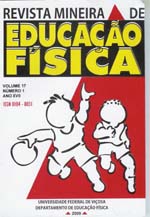HANDBALL GOALKEEPER PERCEPTUAL-MOTOR CHARACTERISTICS: A REVIEW
Keywords:
handball, goalkeeper, perceptual-motor abilitiesAbstract
This study sought to investigate what are the team handball goalkeeper main perceptual-motor characteristics. An integrative review was carried out with a sample of 14 papers from Scopus, PubMed, Lilacs and Scielo databases. The results showed that the perceptualmotor characteristics more related to the performance of team handball goalkeepers are visual perception, anticipation, reaction time, attention, positional strategies, focusing and memorization of the opponent actions. We conclude that goalkeepers are dependent on the visual perception to be able to successfully anticipate the trajectory of the ball; they also depend on having a low reaction time to respond to stimuli, have an ability to select relevant stimuli through selective attention and sustain that attention throughout the game. Besides that, memorizing the actions of opponents helps the goalkeeper as similar stimuli may generate similar responses, and finally, the use of positional strategies to help intercepting the ball.
Downloads
References
BIDEAU, Benoit et al. Using virtual reality to analyze links between handball thrower kinematics and goalkeeper's reactions. Neuroscience Letters, v. 372, n. 1, p. 119-122, 2004.
CAÑAL-BRULAND, R.; SCHMIDT, M. Response bias in judging deceptive movements. Acta Psychologica, v. 130, n. 3, p. 235-240, 2009.
CAÑAL-BRULAND, Rouwen; VAN DER KAMP, John; VAN KESTEREN, Joep. An examination of motor and perceptual contributions to the recognition of deception from others’ actions. Human Movement Science, v. 29, n. 1, p. 94-102, 2010.
DACOSTA, Lamartine et al. Atlas do esporte no Brasil. Rio de Janeiro: Shape, 2005. p. 793-795.
DUMITRU, D. C. The importance of a specific warm-upon the performance of the handball goalkeeper. Journal of Physical Education & Sport/Citius Altius Fortius, v. 28, n. 3, 2010.
GANONG, Lawrence H. Integrative reviews of nursing research. Research in Nursing & Health, v. 10, n. 1, p. 1-11, 1987.
GUTIERREZ-DAVILA, Marcos et al. Anticipatory strategies of team-handball goalkeepers. Journal of Sports Sciences, v. 29, n. 12, p. 1321-1328, 2011.
INTERNATIONAL HANDEBOL FEDERATION. Disponível em: <www.ihf.info>. Acesso em: 14 nov. 2015.
JARRAYA, Sana et al. Effect of time of day and partial sleep deprivation on the reaction time and the attentional capacities of the handball goalkeeper. Biological Rhythm Research, v. 45, n. 2, p. 183-191, 2014.
JUSTIN, Igor et al. Are taller handball goalkeepers better? Certain characteristics and abilities of slovenian male athletes. Kineziologija, v. 45, n. 2, p. 252-261, 2013.
KAJTNA, Tanja et al. Psychological characteristics of Slovene Handball goalkeepers. Kineziologija, v. 44, n. 2, p. 209-217, 2012.
LOFFING, Florian; HAGEMANN, Norbert. Skill differences in visual anticipation of type of throw in team-handball penalties. Psychology of Sport and Exercise, v. 15, n. 3, p. 260-267, 2014.
LOFFREDO, M.; GRECO, P. J. Capacidade técnica: posições básicas de defesa de bola. In: GRECO, P. J. Caderno do goleiro de handebol. Belo Horizonte, 2002. p. 35-46.
MAGILL, Richard A. Aprendizagem motora: conceitos e aplicações. Tradução da 1.ed. São Paulo: Editora Edgard Blücher, 1984. 273 p.
MANN, David L.; SCHAEFERS, Teuntje; CAÑAL-BRULAND, Rouwen. Action preferences and the anticipation of action outcomes. Acta Psychologica, v. 152, p. 1-9, 2014.
MEDINA, Antonio Antúnez et al. Entrenamiento perceptivo en la portera de balonmano ante la trayectoria del tiro. Revista Internacional de Medicina y Ciencias de la Actividad Física y del Deporte, n. 37, p. 3, 2010.
MENZEL, H. J. Aspectos biomecânicos da técnica do goleiro de handebol. In: GRECO, P. J. Caderno do goleiro de handebol. Belo Horizonte, 2002. p. 73-76.
RIVILLA GARCÍA, Jesús et al. A comparative analysis of visual strategy in elite and amateur handball goalkeepers. Journal of Human Sport and Exercise, v. 8, n. 3, p. 743-753, 2013.
ROCHA, E. K. et al. Análise do arremesso do handebol a partir das velocidades de segmentos e bola. In: CONGRESSO BRASILEIRO DE BIOMECÂNICA, 10., 2003. Anais... [s.l.:s.n.], 2003.
ROGULJ, Nenad; PAPI?, Vladan. Low side-step kinematic characteristics of handball goalkeeper. Proceedings of Abstracts of BioMed Conference BioMed2005, 2005.
ROJAS, F. Javier et al. Biomechanical analysis of anticipation of elite and inexperienced goalkeepers to distance shots in handball. Journal of Human Kinetics, v. 34, n. 1, p. 41-48, 2012.
RONGLAN, L. T.; RAASTAD, T.; BØRGESEN, A. Neuromuscular fatigue and recovery in elite female Handebol players. Scandinavian Journal of Medicine & Science in Sports, v. 16, n. 4, p. 267-273, 2006.
TRADE, R. Palavra do goleiro. In: GRECO, P. J. Caderno do goleiro de handebol. Belo Horizonte, 2002. p. 9-10.
TYLDESLEY, D. A.; BOOTSMA, R. J.; BOMHOFF, G. Skill level and eye movement patterns in a sport oriented reaction time task. Motor Learning and Movement Behavior: Contribution to Learning in Sport, p. 290-296, 1982.
TYRDAL, S.; BAHR, R. High prevalence of elbow problems among goalkeepers in European team handball?‘handball goalie's elbow’. Scandinavian Journal of Medicine & Science in Sports, v. 6, n. 5, p. 297-302, 1996.
VIGNAIS, Nicolas et al. Virtual thrower vs. real goalkeeper: influence of different visual conditions on performance. Presence: Teleoperators and Virtual Environments/Presence Teleoperators and Virtual Environments, 2010.
WHITTEMORE, Robin; KNAFL, Kathleen. The integrative review: updated methodology. Journal of Advanced Nursing, v. 52, n. 5, p. 546-553, 2005.
Downloads
Published
How to Cite
Issue
Section
License
Os artigos submetidos e publicados são de inteira responsabilidade de seus autores, não refletindo necessariamente a opinião do Comitê Editorial. A revista se reserva o direito de efetuar, nos originais, alterações de ordem normativa, ortográfica e gramatical, com vistas a manter o padrão culto da língua, respeitando, porém, o estilo dos autores. O manuscrito submetido deve ser original, não podendo ter sido publicado em qualquer outro veículo de informação científica, e nem submetido para publicação em outra revista científica. Os trabalhos publicados passam a ser propriedade da revista Mineira de Educação Física, ficando sua reimpressão total ou parcial de acordo com a licença Creative Commons Attibution 4.0. Deve ser consignada a fonte de publicação original. Os originais não serão devolvidos aos autores. As opiniões emitidas pelos autores dos artigos são de sua exclusiva responsabilidade.





 Esta obra está licenciada com uma Licença
Esta obra está licenciada com uma Licença 